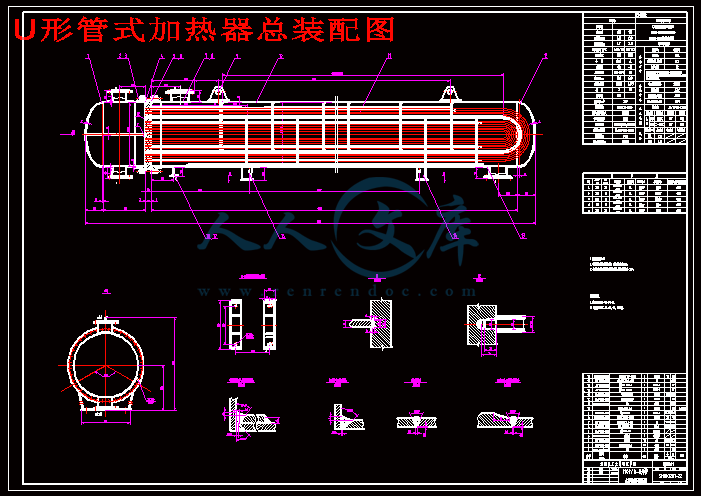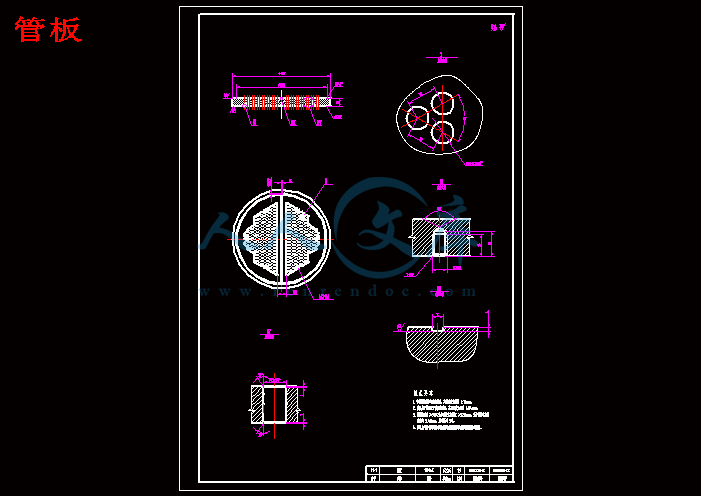流量为110TH的U形管式加热器设计
49页 11000字数+论文说明书+任务书+9张CAD图纸【详情如下】







U形管式加热器总装配图.dwg
U形管式加热器部件图.dwg
折流板.dwg
拉杆.dwg
流量为110TH的U形管式加热器设计说明书.pdf
管板.dwg
设计图纸9张.dwg
摘要
换热器又被叫热量交换器,是一种把热流体的热量传递给冷流体的
设备,并且实现化工生产过程中热量的交换和传递不可缺少的设备,在
工厂中具有重要的意义。管壳式换热器具有可靠性高、适应性广等优点,
在各工业领域中得到最为广泛的应用。U 型管式换热器就是管壳式换热
器的一种,属石油化工设备,由管箱、壳体及管束等主要部件组成,因
其换热管成 U 形而得名。折流板顾名思义是用来改变流体流向的板,常
用于管壳式换热器设计壳程介质流道,根据介质性质和流量以及换热器
大小确定折流板的多少。管板,就是在圆形钢板上钻出比管子外径一样
略大一些的孔,是换热器中起到固定管子以及密封介质作用的圆钢。固
定管板换热器中常用的是 U 型膨胀节,它具有结构紧凑简单,补偿性好,
价格便宜等优点。
已知条件为:设计压力为管程 2.0MPa,壳程 1.9MPa,工作温度管程
90℃,壳程 180℃,设计温度管程 100℃,壳程 200℃,管程介质为水,
壳程介质为高温油。依据给定条件,查 GB151—1999 书第 138 页,通过
试算法获得总传热系数,所得传热面积为 73m2。考虑到介质特性、其他
因素,采用Φ25×2.5 的不锈钢的无缝钢管作换热管,本设计采用 240 根换
热 管 可 满 足 换 热 量 。 设 定 拉 杆 数 量 为 12 , 计 算 得 到 筒 体 直 径 为
DN=700mm。完成了压降计算、管壁温度、传热系数计算等。强度设计
中,依据 GB150 进行筒体、封头强度设计及校核,依据流量进行入口接
管、出口接管等管口直径的选择,依据等面积补强法进行开口补强计算。
本设计选择管板延长兼做法兰,依据 GB151 中的弹性支撑假设对管板进
行设计和校核,管板与换热管的连接方式为焊接,拉杆与管板为螺纹连
接结构。同时,进行了卧式容器鞍座校核。
我设计的 U 型管换热器每根换热管皆弯成 U 形,两端分别固定在同
一管板上下两区,借助于管箱内的隔板分成进出口两室。此种换热器完
全消除了热应力,结构比浮头式简单,但管程不易清洗。
关键字:换热器; U 形管 ; 折流板;管板
Abstract
For heat exchanger was called heat exchanger is a kind of the thermal
fluid heat transfer to the cold fluid equipment, and the realization of chemical
production in the process of heat exchange and transmission of essential
equipment, in the factory has important significance. Shell and tube heat
exchanger has the advantages of high reliability and wide adaptability, and is
widely used in various industrial fields. U type tube heat exchanger is a shell
and tube heat exchanger, is a petrochemical equipment, from the tube box,
shell and tube bundles and other major components, because of its heat
transfer tube into a U shaped and named. Baffle plate as the name suggests is
used to change the flow direction of the plate, commonly used in shell and
tube heat exchanger design shell medium flow channel, according to the
nature of the medium and flow and the size of the heat exchanger to
determine the number of baffles. Tube plate, is in the circular plate drilled
than the pipe diameter as slightly larger hole is change in the heat exchanger
to pipe fixing and sealing the role of the media bar. Fixed tube sheet for heat
exchanger in common is U-type expansion joint, which has simple and
compact structure, good compensatory and cheap price advantage.
For heat exchanger was called heat exchanger is a fluid heat transfer
heat to the cold fluid equipment and known conditions: design pressure
2.0MPa pipes, shell 1.9mpa, working temperature tube process 90 DEG C,
shell of 180 DEG C, design temperature tube process at a temperature of 100
DEG C, shell side 200 DEG C, monitor medium for water, shell side medium
for high temperature oil. According to the given conditions, the GB151 - 1999
book 138th pages, the total heat transfer coefficient was obtained by trial
calculation method, the heat transfer area was 73m2. Considering the medium
characteristics and other factors, the phi 25 x 2.5 stainless steel seamless steel
tube as heat transfer tube and the design the 240 tube can meet the heat
transfer. The number of the set rod is 12, and the diameter of the cylinder is
DN=1000mm. The calculation of the pressure drop, the wall temperature and
heat transfer coefficient were completed. In the strength design and GB150
basis for cylinder head design and strength check, according to the flow of
inlet takeover, outlet nozzle and orifice diameter selection, on the basis of the
area fill method to an opening reinforcement calculation. The design selection
of pipe plate to extend and do the flange, based on the elastic support GB151
assumption on the tube plate design and check, tube plate and heat exchanger
tube connection for welding, tie rod and tube plate for the threaded
connection structure. At the same time, the horizontal vessel saddle check.
I designed the U type tube heat exchanger each tube is bent into a U
shape, both ends were fixed in the same tube plate up and down two areas,
with the tube box of the partition into the import and export room two. The
heat exchanger completely eliminates the thermal stress, simple structure than
the float, but the tube is not easy to clean.
Key words:Heat exchanger ; Baffle plate ; Flange ;Tube-sheet
目 录
第一章综述 1
1.1 换热器的发展及用途1
1.2 换热器结构形式1
1.2.1 换热器的零部件名称. 1
1.2.2 换热器的主要组合部件. 3
1.3 间壁式换热器的类型4
1.3.1 夹套换热器.4
1.3.2 沉浸式蛇管换热器. 4
1.3.3 喷淋式换热器.5
1.3.4 套管式换热器.6
1.3.5 列管式换热器.6
1.3.6 新型高效换热器.8
1.4 换热器的腐蚀原因及防腐措施11
1.5 结论 12
参考文献. 12
第二章换热器传热工艺计算. 14
2.1 起始数据. 14
2.2 定性温度及确定其物性参数 14
2.3 热量守恒与油流量的计算 15
2.4 管程换热系数计算15
2.5 结构的初步设计:17
2.6 壳程换热系数计算17
2.7 传热系数计算18
2.8 管壁温度计算19
2.9 管程压降计算20
第三章 U 型换热器结构设计计算 21
3.1 换热管材料及规格的选择和根数确定.21
3.2 管子的排列方式21
3.3 确定筒体直径21
3.4 筒体壁厚的确定22
3.5 筒体水压试验23
3.6 管程标准椭圆形封头厚度的计算 23
3.7 容器法兰的选择24
3.7.1 设备法兰的选择. 24
3.7.2 接管法兰的选择. 25
3.8 管板的设计.26
3.9 管箱短节壁厚的计算. 27
3.10 拉杆和定距管的确定. 28
3.11 折流板的选择. 29
3.11.1 选型.29
3.11.2 折流板尺寸.29
3.11.3 换热管无支撑跨距或折流板间距29
3.11.4 折流板厚度.29
3.11.5 折流板直径.29
3.12 接管及开孔补强. 30
3.13 分程隔板厚度选取. 32
3.14 支座的选择及应力校核. 32
3.14.1 支座的选择.32
3.14.2 鞍座的应力校核. 33
第四章结论 37
参考文献 38
致谢 40
第一章综述
1.1 换热器的发展及用途
能源是当前人类面临的重要问题之一,能源的开发及转换利用已成为各国的
重要课题之一,而换热器是能源利用的过程中必不可少的设备,几乎一切工业领
域都要使用它,化工、冶金、动力、交通、航空与航天等一些部门应用尤为广泛。
近几年由于新技术发展和新能源开发和利用,各种类型的换热器越来越受到工业
界的重视,而换热器又是节能措施中较为关键的设备之一,因此,无论是从工业
的发展,还是从能源的高效利用,换热器的合理设计、制造、选型和运行都具有
非常重要的发展意义。
近年来随着节能技术的快速发展,应用领域不断扩大,利用换热器进行高温
和低温热能回收带来了显著的经济效益。换热器分类方式有多样形式,按照其工
作原理可分为:直接接触式换热器、蓄能式换热器和间壁式换热器三大类型,间壁
式换热器又可分为列管式和板壳式换热器两类型,其中列管式换热器以其高度的
可靠性和广泛的适应性,在长期的操作过程中积累了丰富的实用经验,其设计资料
比较齐全, 随着经济的发展,各种不同型式和种类的换热器发展都很快,新结构、
新材料的换热器不断涌现出来。
近年来尽管列管式换热器也受到了新型换热器的严峻挑战,但由于它具有结
构简单、牢固、操作弹性大、应用材料广等一些优点,列管式换热器目前仍是化
工、石油和石化行业中使用的主要类型的换热器,尤其在高温、高压和大型换热
设备中仍占有显著的优势。
1.2 换热器结构形式
1.2.1 换热器的零部件名称
第四章结论
通过被课题的学习与研究,基本完成了 U 型管式换热器的设计任务,收获
颇丰,虽然设计任务完满完成,但是设计中尚有需要改进和完善之处。
成果:(1)通过设计过程对过去学到的专业知识进行了系统的回顾和学习;(2)
较全面的了解和学习了 U 型管式换热器设计的设计步骤和设计要求;(3)学习
了换热器设计中常用的规范和标准;4)了解了焊接工艺常用的规范和技术要求;
(5)懂得了独立研究和思考问题的方法。
不足:(1)对于管箱隔板的设计研究还不够深入,设计部够精准;(2)接管
的补强设计还需完善,以使结构更加美观和经济; 3)由于设计压力较高有些结
构需要自行设计,设计经验少,研究不够深入设计的结构还需完善和完美。
此次设计已经结束,受益匪浅,设计规范中一些细节之处可参考的资料较少,
在设计过程中遇到的一些难以解决的问题。苦于自身知识结构还不够完善,缺乏
深度,希望在以后的工作中不断充实与完善自我知识。
参考文献
[1] 金志浩.管壳式换热器原理与设计[M].沈阳:辽宁科学技术出版社,2001:1-1.
[2] 刘月芹.浅谈换热器的分类和特点[J].化工设计通讯,2003,29(3):39-42.
[3] spence.J.Tooth.A.S.Pressure Vessels Dessign:Concepts and Principles.Oxford:Alden Press
UK 1994.
[4] 杨长威.姜爱华,周勤等.肋片管式蒸发器的计算机辅助设计[J].机电工程,2002,
19(5):1-3.
[5] 陈维汉.板翅式换热器综合考虑传热、流动与结构的优化设计[J].化工装备技术,2004,
25(1):27-32.
[6] 郑钢,杨强.翅片管换热器最佳回路长度的仿真计算[J].制冷与空调,2006,6(4):48-51.
[7] 董玉军,包涛,胡跃明等.板式蒸发器换热性能的数值模拟 1:数学模型[J].制冷空调
与电力机械,2004,25(4):10-13.
[8] 董玉军,包涛,胡跃明等.板式蒸发器换热性能的数值模拟 2:结果及分析[J].制冷空
调与电力机械 2004,26(5):16-21.
[9] 胡跃明,董玉军,周翔等.人字形波纹板式蒸发器数值模拟[J].制冷与空调,2005,
5(2):42-46.
[10] 黄兴华,王启杰,王如竹.基于分布参数模型的满液式蒸发器性能模拟[J].上海交通
大学学报,2004,38(7):1164-1169.
[11] 宋伟宏,赵辉,臧润清等.直接蒸发式表面冷却器的结霜状况计算机模拟计算[J].天
津商学院学报,2002,22(6):3-6.
[12] 陈楠,申江,徐烈等.管翅式表冷器数值模拟与性能分析[J].低温与超导,2003,31(2):
60-64.
[13] 赖建波,车晶,苏文.肋片管式换热器表面结霜问题的研究[J].暖通空调,2004,(3):
17-21.
[14] 曾文良,林培森,王世平等.板式换热器作为压缩机冷却器的传热和流阻性能实验研
究[J].流体机械,1999,27(12):5-8.
[15] 冯国红,曹艳芝,郝 红.管壳式换热器的研究进展[J].化工技术与开发,2009,38(6):
41-45.
[16] 金国梁,陈琳,张爱林.可靠性与优化及其在石油工业中的应用[M]. 北京:中国科
学技术出版社,1992:36-37.
[17] Kiefner J F.Vieth P H.New method corrects criterion for evaluating corroded pipe[J].Oil &
Gas Journal,1990(6):56-59.
[18] Hopkins P,Jones D G.A study of the behavior of long and complex-shaped corrosion in
transmission pipelines,Conference on offshore mechanics and arctic engineering[C].New
York:ASME,1992,5(A):211-217.
[19] 丰艳春,方强.波纹管式换热器(三)—强化传热机理[J].管道技术与设备,1998,12(3):
41-42.
[20] 赵晓曦,邓先和,陆恩锡.空心环支撑菱形翅片管油冷器的传热性能[J].石油化工设
备,2003,32(1):1-3.
[21] Mukherjee Rajiv.Broaden Your Heat Exchanger Design Skills[J].Chemical Engineering
Progress,1998,40 (3):35-47.
致谢
致 谢
毕业设计即将结束,在金丹老师的指导和同学的帮助之下,学生对于换热器
设计有了更多新的认知,对 u 型管换热器设计有了更深一步的认识,对换热器综
合设计的整体脉络了解得更加的清晰透彻。通过毕业设计,学生对自己大学四年
以来所学的知识有更多的认识。
毕业设计,帮助我们总结大学四年收获、认清自我。同时,还帮助我们改变
一些处理事情时懒散的习惯。从最开始时的搜集资料,整理资料,到方案比选,
确定方案,u 型管换热器设计,每一步都衔接紧密,其中任何一个步骤产生遗漏
或者疏忽,就会对以后的设计带来很多的不便。学生的动手能力和资料搜集能力
在设计中也得到提升。毕业设计中很多数值、公式、计算方法都需要我们去耐心
地查阅书籍,浏览资料,设计中需要用到辅助设计软件的地方,也需要我们耐心
的学习。掌握其使用的要领,运用到设计当中去。最后汇总的时候,需要将前期
各个阶段的工作认真整理。
毕业设计结束了,通过设计,学生深刻领会到基础的重要性,毕业设计不仅
仅能帮助学生检验大学四年的学习成果,更多的是毕业设计可以帮助我们更加清
楚的认识自我,磨练学生的意志与耐性,这会为学生日后的工作和生活带来很大
的帮助。
感谢与我并肩作战的舍友与同学们,感谢关心我支持我的朋友们,感谢学校
领导、老师们,感谢你们给予我的帮助与关怀;感谢沈阳化工大学科亚学院,特
别感谢机械交通与工程系四年来为我提供的良好学习环境,谢谢!
 川公网安备: 51019002004831号
川公网安备: 51019002004831号